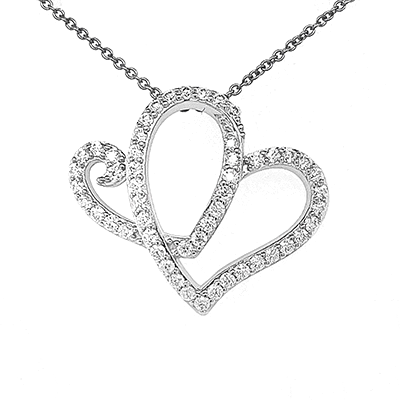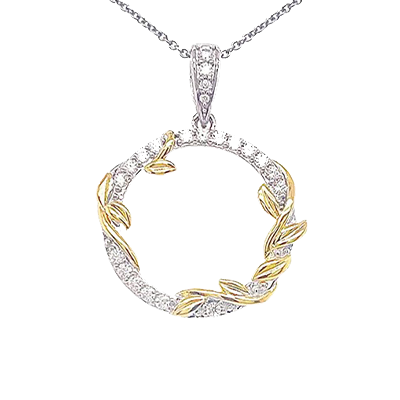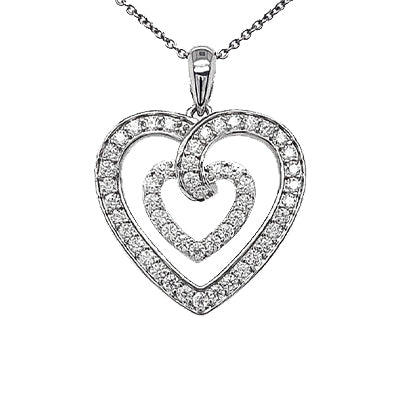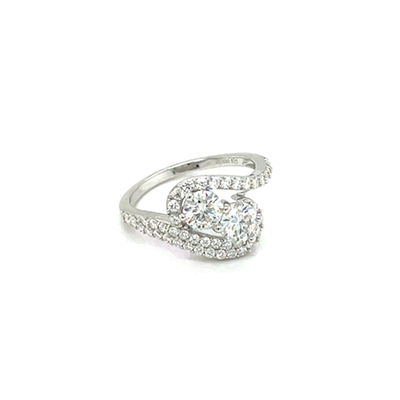Cubic Zirconia
Cubic Zirconia (CZ) is an inexpensive diamond alternative with many of the same qualities as a diamond. Cubic zirconia crystals are made by melting powdered zirconium and zirconium dioxide together, heating them up to 4,982ºF. A cubic zirconia is a perfectly man-made, flawless stone that is free of inclusions. This crystalline material, also known as CZ, is synthetic, which means it is created in a laboratory. Due to increased demand, commercial production of CZ began in the 1970s. Despite appearing similar to the naked eye, diamonds and cubic zirconia stones could not be more different. Here are some of the ways they differ:
A chunk of cubic zirconia is heavier than a diamond of the same size, but not as hard. CZ is rated at 8.5 on the Mohs scale, versus diamond (the hardest substance) at 10 and corundum (sapphire and ruby) at 9.
Cubic zirconia can be transformed into the same popular cuts and shapes that areused for diamonds and colored gemstones.
A white CZ is truly colorless, with none of the inclusions found in an untreated diamond—think of it as a little too perfect.
Cubic zirconia produces more flashes of color (fire) than a diamond.
Some of today's CZ is coated with a product that makes the stones more durable andlessons their fire—the stones look more like true diamonds, although a jeweler will know they are not.
Colorful versions of CZ are available, too, and have become popular in sync with the trend towards fancy color diamonds.
The Mohs Scale
The Mohs scale measures a mineral's durability and hardness. It's a qualitative grading system that determines the scratch-resistance of different minerals using harder, stronger minerals than the one being tested. The scale is named after German geologist and mineralogist Friedrich Mohs, who invented the grading system in 1812.
Grades Of Cubic Zirconia
Cubic zirconia can be evaluated using the same qualities that diamonds and other gemstones are graded by using the Four Cs (color, clarity, cut, and carat weight). Their grading is handled a little differently:
The quality of CZ's manufacturers does vary—some types are less desirable than others, and clarity is one characteristic that may differ. A five-tiered system of A (lowest grade) to AAAAA (highest grade) is used to designate cubic zirconia qualities, but most retail jewelry stores (online or off) do not refer to the grades; they're often seen when purchasing wholesale cubic zirconia.
Cleaning Of Cubic Zirconia Jewelry
Cubic zirconia itself can be cleaned in an ultrasonic jewelry cleaner, but consider the setting materials before you drop the jewelry into the tank and turn on the switch. Use a less intense method to clean CZ jewelry crafted from sterling silver or from plated metals—dishwashing detergent and a very soft brush may be all it takes to remove the film from the CZ and return its fire.Store cubic zirconia jewelry by itself, or well separated from gemstones that are rated as harder or softer on the Mohs scale—that type of storage is important for all jewelry to avoid scratches.
Moissanite
-
Moissanite was first discovered while looking at rock samples from a meteor crater in 1893. The man who discovered it was a French chemist named Henri Moissan. Moissanite was promptly named after Moissan himself. At first he thought the stones were diamonds, due to their similarity. After some testing he found that the crystals were silicon carbide. This beautiful discovery from a meteorite is why people say moissanite was born from the stars. However, it turns out moissanite isn't just out among the cosmos, it is also found inside certain rocks on earth. Discoveries showed that it very, very rarely occurs naturally, more rarely than diamonds. Because of this, when many see moissanite, they see the essence and beauty of a dying star far away, captured in a stone. The love for moissanite jewelry started to arrive in 1998 in which it was regarded as the best diamond alternative. People loved the fact that it was affordable, ethically mined, and just as beautiful as traditional diamonds. Some say it's even more brilliant than traditional diamonds. Moissanite scores higher on the refractive index, meaning more of the "sparkle effect". Moissanite is also a 9.5 on the mohs scale of mineral hardness with a diamond being a 10.
-
Both diamonds and moissanite are very high on the refractive index, which gives the stones their sparkle. However, moissanite is higher on the refractive index, making it more "brilliant" when exposed to light. Secondly, light goes through moissanite in a different fashion than diamonds and creates more of that fiery, slight rainbow flash.
-
Both diamonds and moissanite are very high on the refractive index, which gives the stones their sparkle. However, moissanite is higher on the refractive index, making it more "brilliant" when exposed to light. Secondly, light goes through moissanite in a different fashion than diamonds and creates more of that fiery, slight rainbow flash.
Moissanite Color Grades
Color grade refers to the amount of color present in the stone graded from a scale of D for colorless to Z for a slight yellow tint. Moissanite color grades are broken down into three major groups:
Colorless: Comparable to a D, E, or F color grade
Slightly Colorless: Comparable to a G, H, or I color grade
Yellow Tinted: Comparable to a J or K color grade
Moissanite Clarity Grades
Clarity grade indicates the number of imperfections, known as inclusions. Nearly all gemstones have inclusions, but luckily for moissanite, most of its inclusions are not visible to the naked eye and require intense magnification to be seen. Moissanite’s clarity is graded depending on the number of inclusions the stone has. These grades can be brown down into five easy to understand categories:
FL, IF: Flawless and internally flawless
VVS1, VVS2: Very, very slightly included
VS1, VS2: Very slightly included
SI1, SI2: Slightly included
I1, I2, I3: Included
For diamonds, carat weight refers to how heavy the stone is. However, moissanite is less dense than diamonds which makes the two stones difficult to compare by weight. Due to the density difference, a moissanite’s “carat weight” is denoted by the stone’s size in millimeters. For example, a one-carat diamond is comparable to a 6.5mm moissanite.
Created Diamonds
Created diamonds, (Man Made diamonds, Lab Grown, and Cultured diamonds) use advanced technological processes that duplicate the conditions under which diamonds naturally develop. These lab created diamonds consist of actual carbon atoms arranged in the characteristic diamond crystal structure. Since they are made of the same material as natural diamonds, they exhibit the same optical and chemical properties.
Created diamonds are made from the tiny carbon seeds of pre existing diamonds. Advanced technology – either extreme pressure and heat or a special deposition process known as CVD – mimics natural diamond formation and High Pressure, High Temperature (HPHT): A man-made diamond is produced in a laboratory or factory by mimicking the high-pressure, high-temperature conditions that form natural diamonds in the Earth. Within a growth chamber, a source of carbon dissolves in a molten metal, and carbon atoms travel through the metal to a small man-made or natural diamond seed to produce a distinctively shaped man-made diamond crystal.
Man Made diamonds may also undergo pressure and heat treatment after they are grown. Fancy colored diamonds are formed when small amounts of specific trace elements are present during the growth phase of the created diamond, just like in nature. Created diamonds can only be distinguished from natural diamonds using specialized equipment that can detect the minor differences in trace elements and crystal growth.
Benefits Of Created Diamonds
A diamond that is created in a lab is just as real as a mined diamond. They have the same physical and chemical properties and are grown under the same temperature and pressure conditions, but without the conflict and questionable ethical practices that are common in some diamond mines. In fact, lab created diamonds are often of better quality due to the highly controlled environment and fully monitored process. Some of the biggest advantages of a lab created diamond include:
More beautiful due to better, brighter quality and higher purity
Fewer defects
Environmentally friendly
Greater affordability
Colors that are rarely found in nature can be created, making unique and coveted pieces more obtainable
Trackable origin sources allow you to source diamonds from reputable places that don't engage in poor treatment of workers or communities
Certification And Grading Of Created Diamonds
The process for grading lab grown diamonds is the same as traditional diamonds and focuses on the cut, clarity, carat, and color of each gemstone. The cut is responsible for the brilliance of the diamond, and arguably the most important factor. Clarity refers to the appearance and lack of cracks and defects. When referencing clear diamonds, the lack of color makes a higher grade. Finally, carat is the measure of the diamond's size and weight. Each diamond is examined carefully and assigned a quality rating.
A piece of diamond jewelry can be a wonderful gift for yourself or someone you love. Diamonds are highly versatile and can be worn as everyday jewelry, or for special occasions. When you choose a lab grown diamond, you can invest in a high-quality and stunning piece that is also ethical and environmentally friendly.
Created Sapphires
Crystal gemstones develop or “grow” when the right combinations of minerals interact under specific chemical and physical conditions. The chief advantages of creating gems in a laboratory are time and financial savings. In a lab, manufacturers can control and even accelerate chemical and physical processes as well as combine minerals that occur rarely in nature. In effect, labs can create to order gems difficult or expensive to mine.
There are two types of methods for artificially creating sapphires: melt processes, which involve melting aluminum oxide into a sapphire droplet, and solution processes, which grow sapphire crystals in a solution. The most inexpensive and oldest method is the melt process, also known as flame fusion. In this method, a flame melts aluminum oxide powder. The drops form into a long teardrop shape called a “boule.” The addition of other minerals to the aluminum oxide can create colored varieties of sapphire. Also, adding chromium to the aluminum oxide will create synthetic ruby.
The Verneuil process is a flame fusion process that can create sapphires much larger than those commonly found in nature.
Another melt process, the Czochralski process, uses radio waves to melt the aluminum oxide. Manufacturers insert a rod tipped with a seed crystal into the mixture and slowly rotate it and pull it out, creating a column of sapphire. Although an expensive way to synthesize sapphires, it can create up to 4” of crystal per hour.
Another melt process, the Czochralski process, uses radio waves to melt the aluminum oxide. Manufacturers insert a rod tipped with a seed crystal into the mixture and slowly rotate it and pull it out, creating a column of sapphire. Although an expensive way to synthesize sapphires, it can create up to 4” of crystal per hour.
The other method used is the Hydrothermal synthesis, which is a solution process that closely resembles natural formation, subjecting the minerals to intense heat and pressure in a sort of “pressure cooker.” Sapphires form around a seed crystal as the mineral solution rises to the top of the cooker.
Chemically and physically speaking, the same materials constitute natural and Created sapphires, and they have the same atomic structure. Gemology labs would identify both lab-grown and natural sapphires as
forms of corundum.
Natural Diamonds
Natural Diamond’s distinctive properties come about during their formation process. Diamond formation can occur in one of three ways:
The Earth’s Mantle:
The first formation method is for diamonds that were created within the Earth’s mantle between one and three billion years ago. These stones are formed within diamond stability zones which contain the perfect environment for a diamond to form. Diamonds are formed about 100 miles below Earth’s surface, with at least 2,000 degrees Fahrenheit and 725,000 pounds of pressure per square inch. In this environment, carbon atoms form a rigid bond with each other, resulting in outstanding durability. Deep-source volcanic eruptions help bring these diamonds to the Earth’s surface. These types of volcanoes are three times as deep as typical volcanoes. High amounts of magnesium and carbon dioxide force the volcano’s magma to the surface, causing a powerful eruption. These deep eruptions are pushed through cracks in the Earth called Kimberlite pipes and carry diamonds during their ascension.
Subduction Zones:
Diamonds can form in subduction zones, which are when two tectonic plates meet and one plate is forced down the Earth’s mantle. During this time, carbon rocks are exposed to the mantle’s heat and the pressure from the colliding plates. This great heat and pressure can create diamonds, however, the resulting diamonds are too small for jewelry and industrial use.
Asteroids:
Diamonds can also form when an asteroid hits earth, which creates intense heat and pressure. These diamonds are mainly used for industrial purposes because they are small and do not meet the desired qualities for jewelry piece diamonds.
Natural White & Colored Diamonds
White diamonds are essentially colorless and are devoid, or have very few minerals, that will alter its color, such as nitrogen. When diamonds are evaluated, one of the characteristics that gemologists look at is a diamond’s color. White diamonds are graded on a scale from D to Z, where D is colorless and Z is a light yellow. Ideally, a white diamond should have a color grade as close to D as possible.
Diamonds can come in an array of colors because of mineral contamination during the formation process or changes in its molecular structure. Below are several fancy colored diamonds along with what gives them their distinctive color. Unlike white diamonds, fancy colored diamonds do not have a letter color grade, instead they are graded from a scale of Fancy Light to Fancy Vivid depending on their color intensity. It takes a highly trained gemologist to identify a diamond’s proper color. The bottom line is that for fancy colored diamonds: the stronger, more vivid the diamond color, the more the diamond is worth.
Diamond has a wide band gap of 5.5 eV corresponding to the deep ultraviolet wavelength of 225 nanometers. This means that pure diamond should transmit visible light and appear as a clear colorless crystal. Nitrogen is by far the most common impurity found in gem diamonds and is responsible for the yellow and brown color in diamonds. Boron is responsible for the blue color [53] Color in diamond has two additional sources: irradiation (usually by alpha particles), that causes the color in green diamonds, and plastic deformation of the diamond crystal lattice. Plastic deformation is the cause of color in some brown[54] and perhaps pink and red diamonds.[55] In order of increasing rarity, yellow diamond is followed by brown, colorless, then by blue, green, black, pink, orange, purple, and red.[31] "Black", or carbonado, diamonds are not truly black, but rather contain numerous dark inclusions that give the gems their dark appearance. Colored diamonds contain impurities or structural defects that cause the coloration, while pure or nearly pure diamonds are transparent and colorless. Most diamond impurities replace a carbon atom in the crystal lattice, known as a carbon flaw. The most common impurity, nitrogen, causes a slight to intense yellow coloration depending upon the type and concentration of nitrogen present [31] The Gemological Institute of America (GIA) classifies low saturation yellow and brown diamonds as diamonds in the normal color range, and applies a grading scale from "D" (colorless) to "Z" (light yellow). Yellow diamonds of high color saturation or a different color, such as pink or blue, are called fancy colored diamonds and fall under a different grading scale.[31]
Natural Diamond Clarity
Clarity is one of the of 4C's(Color, clarity, cut and carat weight) that helps in identifying the quality of diamonds. The Gemological Institute of America (GIA) developed 11 clarity scales to decide the quality of a diamond for its sale value. The GIA clarity scale spans from Flawless (FL) to included (I) having internally flawless (IF), very, very slightly included (VVS), very slightly included (VS) and slightly included (SI) in between. Impurities in natural diamonds are due to the presence of natural minerals and oxides. The clarity scale grades the diamond based on the color, size, location of impurity and quantity of clarity visible under 10x magnification [59] Inclusions in diamond can be extracted by optical methods. The process is to take pre enhancement images, identifying the inclusion removal part and finally removing the diamond facets and noises.[60]
Natural Diamond Hardness
Diamond is the hardest known natural material on both the Vickers scale and the Mohs scale. Diamond's great hardness relative to other materials has been known since antiquity, and is the source of its name. Diamond hardness depends on its purity, crystalline perfection, and orientation: hardness is higher for flawless, pure crystals






